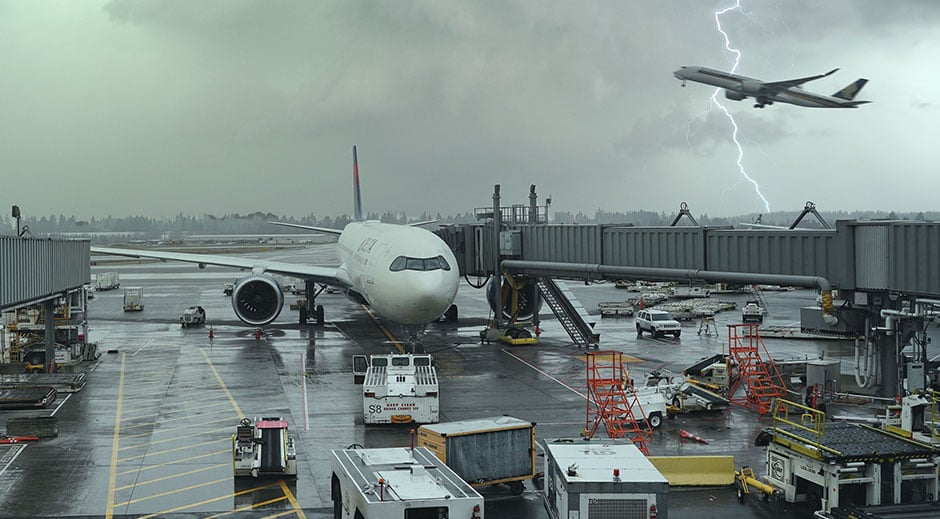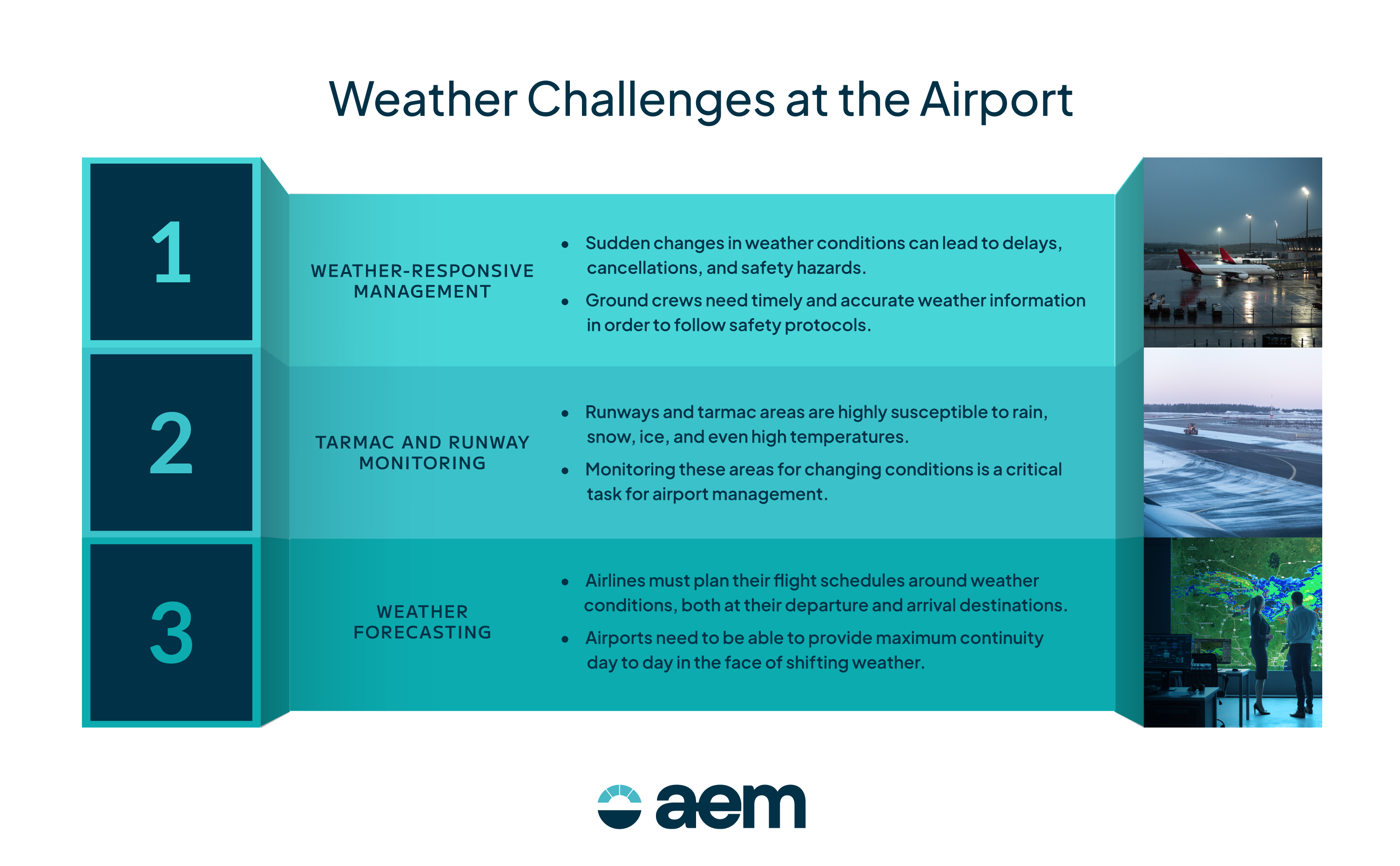
As extreme weather events become increasingly frequent and unpredictable, the aviation industry is faced with a growing challenge: how can airports and airlines effectively manage risk in an ever-changing climate?
It’s time to revolutionize the way airports and airlines plan ahead for and respond to potential disruptions caused by adverse conditions. Emerging weather monitoring technology and services can provide leaders with more actionable intelligence than ever while also automating the response at ground level. Moving forward, we'll...
- Introduce the growing weather safety challenges in the aviation industry
- Discuss how airports and airlines can use technology to mitigate weather-related delays and disruptions
- Explain the benefits of custom forecasting for enhanced weather safety
- Discuss how weather station networks can help increase accuracy and reliability of information on a large scale
- Explore how airports and airlines can take the next step forward toward severe weather resilience

What kind of weather do airlines and airports need to be aware of?
As we continue to see more variable weather globally, the aviation industry is faced with growing safety challenges. Lightning strikes present one of the biggest hazards, as they can damage critical airplane systems and electronics, not to mention the risk to workers.
Additionally, ground crew safety is at risk during heavy rain and wind storms, which can make it difficult to manage aircraft movement on the tarmac. Water and ice on runways pose yet another threat, as they can affect aircraft performance during takeoff and landing.
To ensure operational continuity despite these challenges, the aviation industry must place a strong emphasis on weather monitoring and management strategies. By doing so, they can better protect both their personnel and passengers while maintaining a safe and efficient operation.
How weather monitoring and technology can support the aviation industry
Airports and airlines are no strangers to the impact that weather can have on daily operations. However, with advances in technology, there are now ways to mitigate weather-related delays and disruptions.
Weather monitoring systems can provide real-time updates and data analysis for airports and airlines to make informed decisions. Alerts and alarms can be triggered when conditions become severe, allowing for quick actions to be taken. In addition, notifications can be sent to workers and even the public based on roles and relevance to help them know exactly what’s happening and what they need to do to stay safe. By leveraging technology in this way, airports and airlines can better prepare for and respond to weather-related disruptions.
Why custom forecasting is a perfect fit for aviation
The aviation industry relies heavily on meteorological services and custom forecasting for safe and efficient operations. With on-demand access to hyperlocal weather forecasts, airport operations leaders, air traffic controllers, and ground staff can make informed decisions about flight plans and scheduling to avoid potential risks.
The use of better data and intelligence in custom forecasts also brings benefits like optimizing fuel consumption, reducing unnecessary delays, and minimizing the risk of weather-related accidents. With custom forecasting, aviation professionals can get insights tailored to specific routes and airport locations, allowing them to plan ahead and make quick adjustments when necessary.
Overall, meteorological services and custom forecasting are essential tools for the aviation industry, helping to ensure safe and efficient operations in every flight.
How airport weather station networks increase forecasting capacity and safety
Having an accurate weather forecast is crucial for the smooth operations of airlines and airports alike. The implementation of a local weather station network can make a significant impact in this regard. With this technology, forecasting capacity can be greatly increased, which leads to more accurate predictions of weather conditions in the region.
By having access to more powerful insight into local weather patterns, airport personnel and airline operators can make more informed decisions about scheduling, staffing, and equipment maintenance. This actionable data can minimize delays and cancellations, ensuring that passengers reach their destinations safely and on time.
Ultimately, a sophisticated weather station network brings immense value to the aviation industry, making it a wise investment for all those involved.
Taking the first step toward improved weather resilience at your airport or airline
As weather patterns become more unpredictable and severe weather events become more common, it's important for airlines and airports to take steps to weather-proof their operations. One of the first steps is to connect with a weather consultant or solution provider who specializes in the unique challenges that the aviation industry faces.
This expert can conduct a thorough weather assessment of your current approach and help you identify your strengths, weaknesses and areas for improvement. From there, you can make targeted improvements such as increasing your onsite monitoring capacity or connecting with software that can help you respond to changing weather conditions with safety in mind. By taking these proactive steps, you can increase your resiliency and protect your passengers, employees, and assets.
Ready for a chat with a true aviation expert?
AEM provides comprehensive weather solutions to help airports and airlines tackle the industry’s growing weather challenges effectively. We’ve had success across the U.S. and globe helping aviation clients scale weather resiliency solutions to their operations and specific needs with emphasis on:
1. Weather-responsive management solutions
AEM offers real-time weather data and alerts through tools like Sferic Maps and the Sferic Connect app. These tools allow airports to communicate quickly and effectively with employees, helping them establish safety protocols based on current and upcoming weather conditions.
2. Tarmac and runway monitoring solutions
To assist in monitoring airport infrastructure, AEM provides solutions such as water level sensors, in-pavement ice sensors, and comprehensive software to visualize all data in real time, providing data and alerts that enable airports to take action when needed for public safety.
3. Customized weather forecasting solutions
AEM also offers customized weather forecasting services, providing weather dashboards, 24/7 support, and guidance before and after severe weather events. Our dedicated meteorological services team helps airports plan for operational efficiency, safety, and continuity during normal and extreme weather conditions.
These solutions have proven to be invaluable for many airports and airlines. For instance, Kevin Crowley of JetBlue Airways praises AEM's system, saying, "We can customize alerts that are sent out across the system in the event of thunderstorms, high winds, cold temperatures, and lightning. It’s one tool we use that allows us to communicate throughout the system of any impending weather systems that may be approaching one of our cities."


